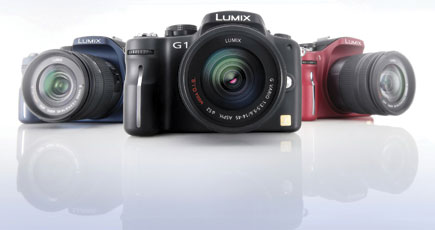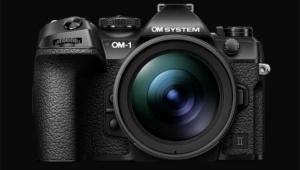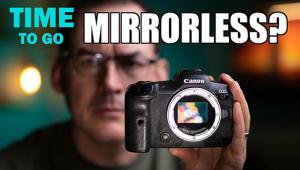Panasonic’s Lumix DMC-G1; The First Interchangeable Lens Digital Camera (ILDC)
Panasonic has developed an Interchangeable Lens Digital Camera (ILDC) that’s not a single lens reflex model. Substantially smaller than a standard D-SLR, the 12.1-megapixel Lumix DMC-G1 is categorized as a Micro Four Thirds camera; that’s only because of the relatively diminutive body size. It’s equipped with a full-size (13.5x18mm) Four Thirds sensor that’s much larger than the (5.76x7.18mm or smaller) chips used in high-resolution digicams. That allows for decent pixel size for greater dynamic range and better image quality at high ISO levels.
 |
This elegant camera—in red, black, or blue—offers great portability. The Lumix G1 also benefits from the best of both worlds: really useful automation borrowed from point-and-shoot cameras plus D-SLR-type capabilities, interchangeable lenses, and comparable image quality. Because there’s no optical viewfinder, TTL viewing is provided by a superior LCD screen and an Electronic Viewfinder (EVF) with very convenient full-time Live View using AF or manual focus. (The G1 sells only as a kit including the 14-45mm lens for $700; the 45-200mm lens is $350.)
Design And Technology
Eliminating the mirror box reduced the distance from the lens mount to the sensor (“flange depth”) by 0.79”, making the camera unusually slim. The lens mount size was also decreased by 0.24” to a mere 1.65”. Because market research indicated that consumers wanted a familiar form factor, there’s a faux “prism” hump so the Lumix G1 resembles a D-SLR. For the same reason, it’s not as small/lightweight as it could be. In fact, the G1 weighs roughly the same as the Olympus E-420 (the most portable D-SLR at the time of this writing).
 |
|
|
On the other hand, the Lumix G1 is smaller in volume: 29.1 cubic inches vs. 38.6 cubic inches. And the G-series lenses are much smaller/lighter than comparable Four Thirds lenses. The Lumix G 45-200mm f/4-5.6 zoom, a 90-400mm equivalent, is particularly petite (2.75x3.9”, 52mm filter mount) and featherweight (13.4 oz, including the stabilizer mechanism), giving the Micro Four Thirds system a major advantage. And yet, the G1, with its rubbery finish and large grip, is adequately substantial for convenient handling even by those with large hands.
A new Live MOS Sensor plus Venus Engine HD provide superior noise reduction as well as independent gradation control for each of the R, G, and B channels. High-tech amenities include an Intelligent Exposure function that lightens only dark areas of a photo by increasing the ISO only in those areas. This feature—called dynamic or tonal range expansion by some D-SLR manufacturers—can be set to low, normal, or high for a shadow lightening effect ranging from extremely subtle to moderate.
Turn the camera on and you’ll notice that the 3” LCD monitor, with 460,000-dot resolution, provides a beautiful, contrasty display that’s visible even in bright conditions. This screen flips out and swivels/rotates so it can be used for framing photos when the camera is at virtually any position. To save battery power, the LCD turns off automatically when a sensor detects use of the EVF. Based on technology developed for broadcast-quality video cameras, the electronic finder employs an LCoS (Liquid Crystal on Silicon) chip with 1.4 million dots and a 60 frame per second (fps) per color refresh rate to minimize flicker.
 |
|
|
The Lumix G1 also offers a unique high-tech amenity: shutter speed effect preview. Select this option before actually taking a photo of a moving subject. The LCD or EVF display will provide a fairly accurate visual representation of the blurring that a specific long shutter speed will produce. The engineers achieved this simulation feature by changing the screen’s refresh rate. Try several shutter speeds before taking a photo of waterfalls, for example, and you’ll know which is likely to produce just the right motion blur effect.
The Lumix G1 does not employ a phase-detect AF system (available with all D-SLRs) because that would require a reflex mirror to bounce light to an AF sensor. This camera employs only contrast-detect AF. That’s available as a user-selectable option with many recent D-SLRs as well, but it’s slower; that’s why Nikon calls it “Tripod mode.” (The Sony A300 and A350 employ unique technology for faster contrast-detect AF, as discussed in my Test Report available at www.shutterbug.com.) The Panasonic engineers addressed that issue with unspecified technology for amazingly fast/accurate contrast-detect AF. The G1 also offers a new function to minimize “focus lag”: in Quick AF mode, focusing starts even before the shutter button is touched.
Intended primarily for use with the small Lumix G-series lenses, the diminutive Lumix G1 will accept many of the Olympus or Leica/Lumix Four Thirds lenses with an optional ($170) DMW-MA1 adapter. Autofocus will work with about half of the larger lenses and, apparently, only in Single-Shot AF mode. The G1—and its competitor from Olympus, still under development—may never be fully compatible with the conventional lenses. Of course, 90 percent of potential buyers are unlikely to want to use full-size lenses in any event.
 |
|
|
Evaluation: Anyone upgrading from a camera with an integral lens—equipped with no viewfinder or a tiny zooming optical finder or a low-resolution EVF—will appreciate Panasonic’s LCoS technology. The Lumix G1 has the best EVF that I have ever tested with a very smooth, sharp, ultrahigh-resolution display. Because there’s no reflex mirror, continuous live preview (with the EVF or LCD) is as convenient as with cameras with a built-in lens. And this “mirrorless” camera is preferable to most D-SLRs in Live View because its contrast-detect AF system is faster.
During extensive testing at cultural events and an equestrian competition, I found only one drawback to Panasonic’s Live View technology. There was some EVF and LCD blackout between shots while I was making a series of panning photos of action moving across my line of vision. After several attempts, however, I became quite adept at keeping a subject properly framed even during the blackout.
Thanks to signal amplification, the electronic display is bright even in dark locations (useful for manual focusing) or when depth of field preview is used at a small aperture. Before taking a photo, you can check the live histogram on the EVF screen and preview the exact effects that various camera features and overrides will produce. And finally, it’s ideal for image playback in very bright conditions when an external LCD screen’s display is “washed out” by strong sun.
 |
|
|
Controls And Feature Set
Initially at least, the Lumix G1 was intended to appeal to those who consider a D-SLR too large and too complicated. Hence, this smaller camera benefits from controls, features, and menu items developed for Lumix models with built-in lenses. That includes a large mode selector dial with a full 13 options and dedicated buttons or switches like those on the DMC-FZ18: for Film mode (picture styles and parameter adjustments), ISO, WB, AF pattern and AF mode, AE Lock, Drive mode, and more. There’s a control dial, too, for selecting an aperture or shutter speed; press the dial and its function changes to exposure compensation control.
















































